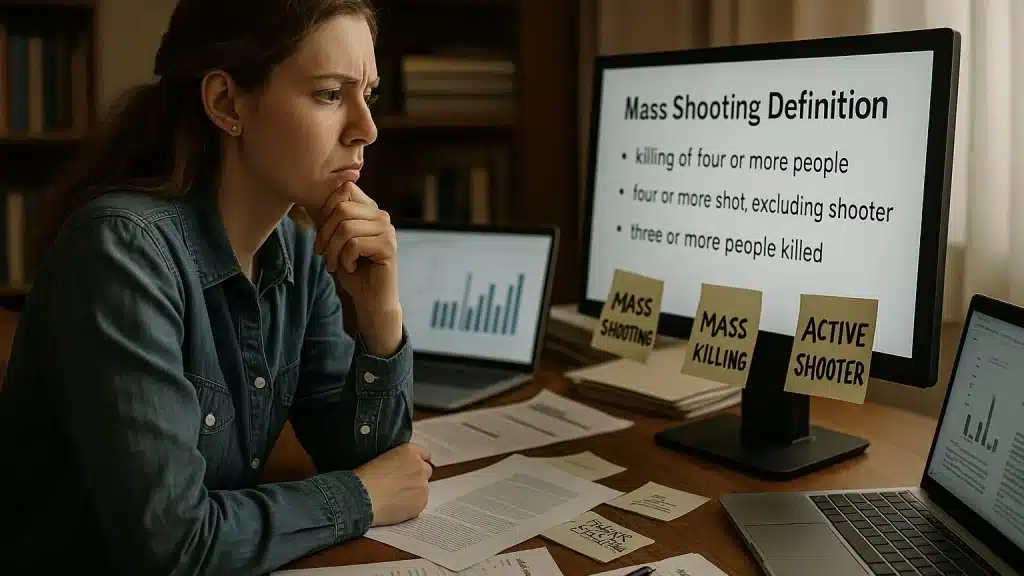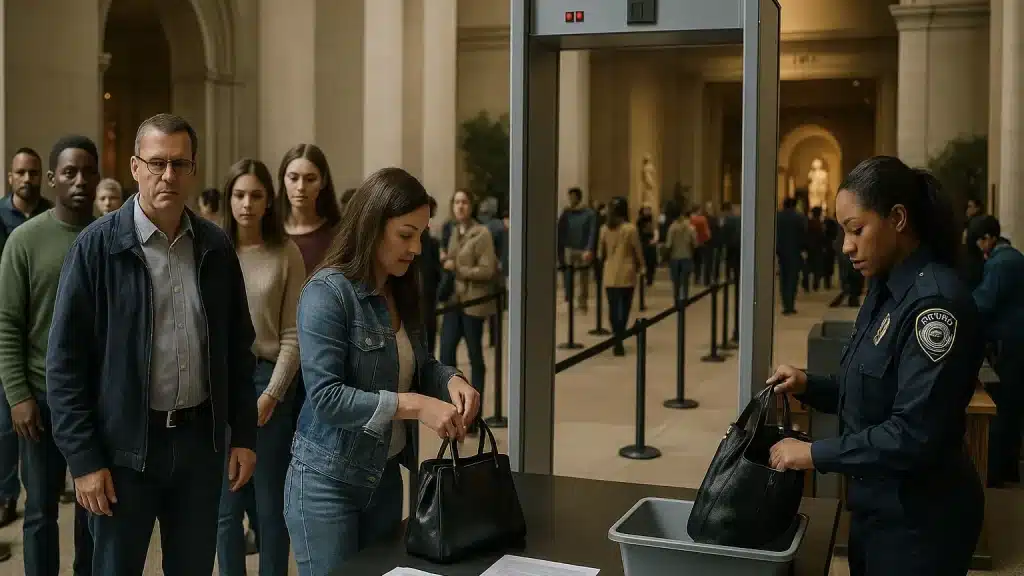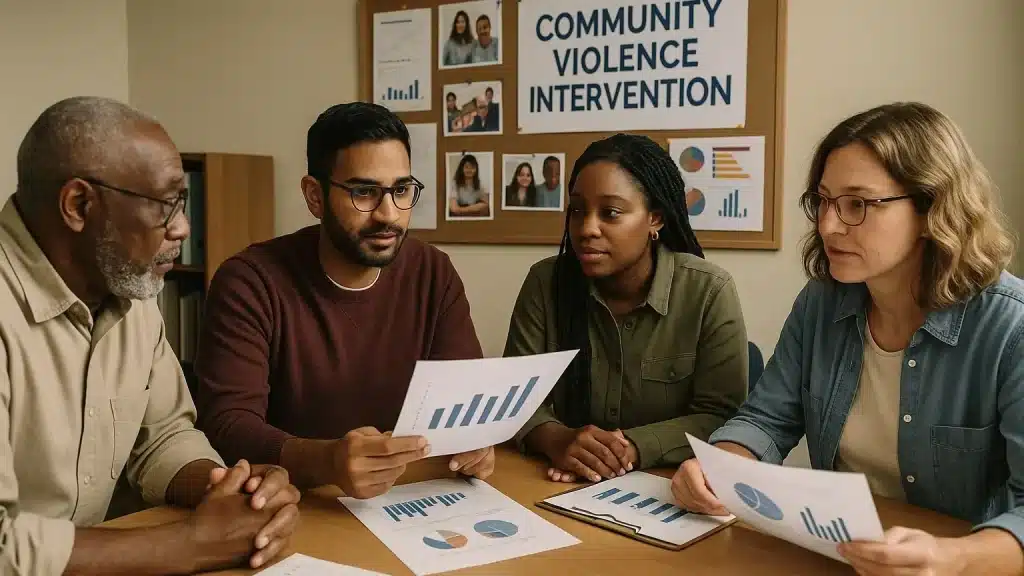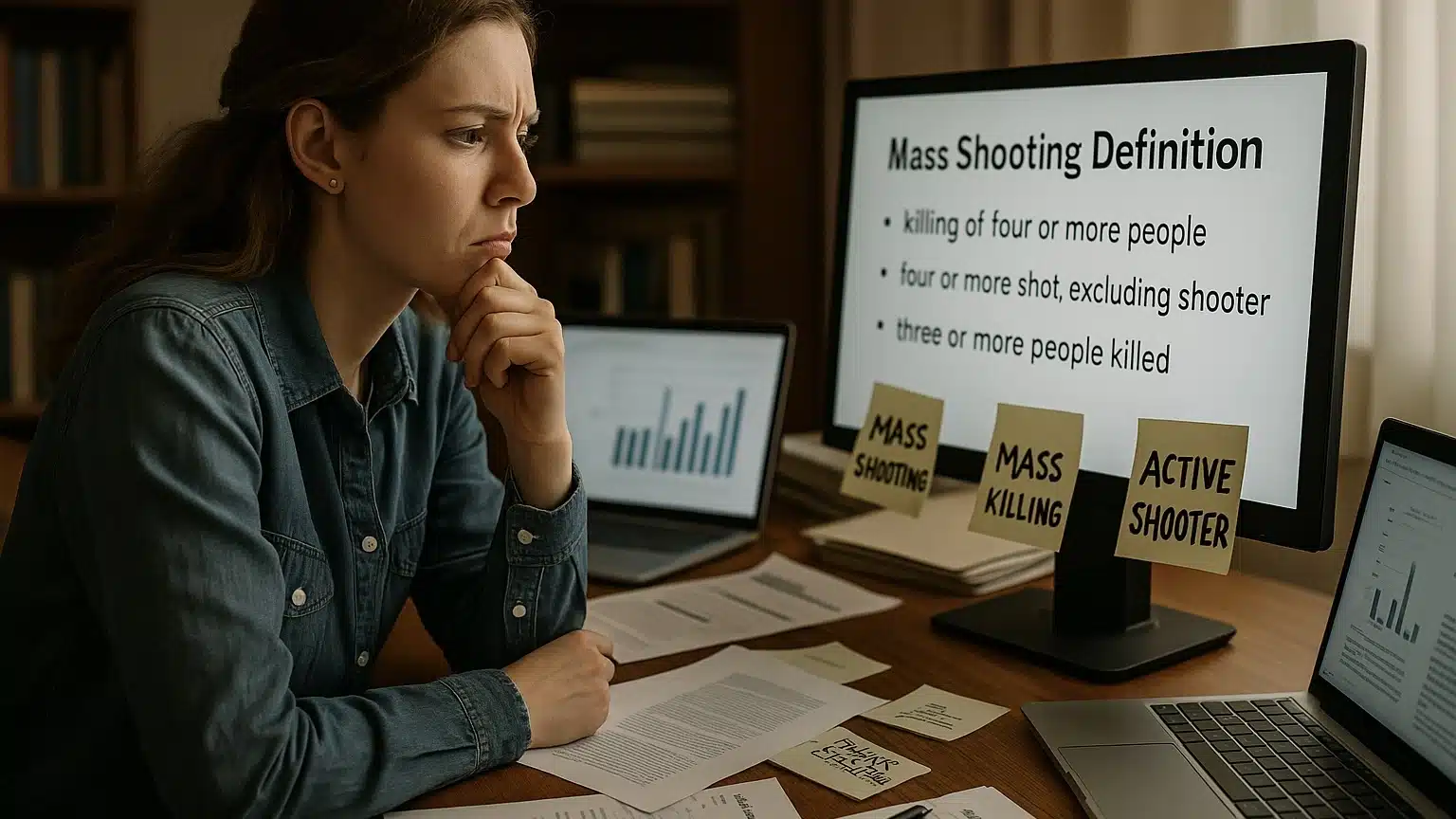
Mass shootings have become an unsettling part of life in the United States. What once felt unthinkable now happens with regularity, in schools, workplaces, commercial centers, and places of worship. Each tragedy leaves behind communities that will never be the same, and a nation still searching for answers.
To have a comprehensive conversation about prevention, we first need to understand what the mass shooting definition actually is, and why that definition isn’t as straightforward as it might seem.
Key Takeaways
- Most definitions describe a mass shooting as an event where there are four or more people shot or killed, but the exact criteria differ from one organization to another.
- The U.S. accounts for 31% of the world’s mass shootings, despite making up only 4-5% of the global population.
- The average age and gender of U.S. mass shooters are males around 34 years old, showing some demographic consistency across incidents.
- Preventing gun violence requires a mix of strategies, from tighter gun laws and stronger community programs to better mental health support and smarter use of technology.
Defining a Mass Shooting
The term “mass shooting” is used widely, but there’s no one universal definition for the term. Mainly, differences stem from questions regarding the victim quantity, whether the count should include only fatalities or also injuries, and whether the shooter’s intent matters. Because different organizations define the term differently, this can cause confusion among the public and contribute to inconsistencies in statistics.
Data on mass shootings, which plays a great role in influencing policy, public perception, and education, comes from a variety of sources: non-governmental organizations (NGOs), research groups, law enforcement agencies, and media outlets. Each uses its own criteria for what constitutes a mass shooting.
Federal Mass Shooting Definitions
Across the federal government, there’s surprisingly no official definition of a mass shooting used across the government. Different agencies use their own criteria, which can make comparisons and data tracking confusing.
- Congress typically uses the term “mass killing,” meaning an incident where there are three or more deaths.
- The FBI takes a broader view, referring instead to “active shooter” incidents. These are cases where the attack is ongoing.
- The Congressional Research Service (CRS) defines a mass shooting as a single event that leaves four or more victims dead, either in one location or across several nearby spots.
The Rockefeller Institute of Government has noted that the term “active shooter” can be misleading, because it only applies while the attack is happening, ignoring incidents that have already ended but still meet the same tragic scale.
These inconsistencies matter. When federal agencies use different definitions, it affects everything from legislation to how the public understands the issue. Without a shared definition, counting and comparing incidents and crafting effective policy or implementing prevention measures is more difficult.
NGOs Definitions
Non-governmental organizations (NGOs) have become some of the most trusted voices when it comes to understanding gun violence. Unlike government agencies, they often work directly with the people and communities most affected: the families, the survivors, and the neighborhoods left to pick up the pieces. That closeness gives them a deeper, more human perspective on what these tragedies really mean.
Groups like Everytown for Gun Safety and the Gun Violence Archive (GVA) define a mass shooting as a single incident where four or more victims are shot, whether they’re killed or injured, and not including the shooter. It’s a simple but important definition, one that’s widely used by researchers and journalists alike. This way of counting doesn’t just focus on fatalities; it captures the full scale of harm.
Characteristics of Mass Shootings

Mass shooting incidents have common characteristics that can be identified to understand and address these tragedies. They are often motivated by personal grievances or extremist ideologies and, depending on the intent and motivation behind the act, can sometimes even be considered a form of domestic terrorism. Knowing these characteristics is essential for developing targeted prevention and intervention strategies.
Common Weapons Used
The type of weapon used in mass shootings plays a significant role in the severity of these incidents. Handguns are the most common type of weapon used in mass shootings, seen in 73-80% of attacks. Assault rifles and semiautomatic rifles get a lot of media attention, but are used in a smaller percentage of mass shootings.
Locations and Settings
Mass shootings happen in many settings, but workplaces, retail, and areas of commerce, like restaurants and bars, are common settings. Together, they make up up to 60% of all mass shootings in the US. Additionally, mass shootings can happen in one or more locations within the same time frame.
Victim and Perpetrator Demographics
Mass shooters are overwhelmingly (98%) male. These killers often have varied backgrounds and motives, which can influence the tragic outcomes of their actions. Their victims are diverse, often one or more of different ages, genders, and ethnicities. In some cases, victims are acquaintances of the mass shooter, and in others, the perpetrator may have a relationship with the location itself. Understanding these demographics is key to tailoring support services and prevention strategies to the majority most affected by mass violence.
Statistics on Mass Shootings
Mass shootings in the U.S. have become part of everyday life in a way that once felt unimaginable. Schools, offices, grocery stores, concerts, and restaurants, all places that should feel safe, can turn into scenes of heartbreak in an instant. While the United States makes up just 4-5% of the world’s population, it’s responsible for about a third of all mass shootings worldwide. The number of mass shootings per year has grown over the past few decades, with certain years having more than others.
There have already been over 300 mass shootings across the country so far in 2025. According to GVA, in 2021, there were 689… one of the worst years on record. Many involved assault-style weapons that turned moments into massacres. There was a drop in mass shootings to 503 in 2024, but overall gun violence is still climbing.
Workplaces alone make up almost a third of all incidents, a reminder that violence can reach people simply going about their day. The financial cost of gun violence is staggering, around $557 billion every year, but the real loss can’t be measured in dollars.
Mass Shootings vs. Other Violent Crimes

Mass shootings are characteristically different from other violent crimes; however, the lack of consistency around terminology and definitions across organizations can cause confusion in data and incident classification, which are often defined by the number of victims and the context in which they happen. Knowing these characteristics of a mass shooting can help prevent and classify them.
Mass Murder and Mass Killings
When it comes to large-scale violence, definitions can be confusing, but they are important. The Investigative Assistance for Violent Crimes Act of 2012 defines a “mass killing” as an event where three or more people are killed in one or more locations. The Federal Bureau of Investigation (FBI) defines “mass murder” as involving four or more victims. These definitions help law enforcement and policymakers understand the scale of violence and guide responses. Clear terms improve data accuracy, laws, and prevention efforts.
Domestic Terrorism
Not every mass shooting is classified as domestic terrorism, even if the devastation feels the same. The distinction often comes down to intent: What motivated the attacker, what actions they took during the incident, and what message they wanted to send. Mass shootings are committed by individuals or groups with specific motivations, and the actions of perpetrators, such as their methods, preparedness, and responses, are key factors in understanding the context of the attack.
Under U.S. law, an act qualifies as domestic terrorism if it’s targeted violence driven by one or more of the following motives:
- A desire to intimidate or coerce the public
- An attempt to influence government policy
- An effort to disrupt or harm the government’s ability to function
In other words, if the violence is meant to advance a political, social, or ideological goal, it crosses the line into terrorism. Understanding these criteria helps investigators and the public alike make sense of why some tragedies are labeled differently, and how motives shape both the response and the narrative that follows.
Impact on Communities

Mass shootings have a deep and wide impact on communities:
- The frequency of these events can cause collective trauma and impact a whole community’s mental health.
- Children and teens across America face higher rates of anxiety and stress due to the constant threat of mass shootings or past exposure, which can impact their school performance.
- Emotional and psychological trauma can extend to survivors, their families, and their communities. In the long term, this can result in fear, grief, and PTSD.
Mass shootings in schools and higher education have been linked to increased absenteeism, lower graduation rates, and lower employment prospects for young adults from affected campuses. They can erode trust among the community and threaten the sense of safety and security that is essential for social cohesion.
Outside of the significant social impacts of mass shootings and gun violence, there are also economic consequences. A report by Everytown for Gun Safety breaks down the costs of gun violence:
- $274,000: The cost of each gun-related death, paid by taxpayers.
- $1.57 billion: The annual cost of medical care for shooting victims, paid by taxpayers. When accounting for the total cost of all long-term medical care, that rises to $2.8 billion annually.
- $11.01 billion: The annual cost of criminal justice services.
- $534.91 million: Annual losses by employers related to gun violence.
- $489.08 billion: The annual cost of lost quality of life, estimated.
The full cost breakdown can be read on the Everytown Research website.
Strategies for Prevention and Response

There’s no single fix for mass shootings. These tragic events can be driven by different purposes, such as ideological, personal, or criminal motivations, which influence the efficacy of prevention strategies. Preventing them, and responding effectively when they happen, takes a combination of smart laws, innovative technology, strong communities, and education. Each plays a role in keeping people safe and reducing the risk of future tragedies.
Legislative Efforts
Across the U.S., state lawmakers have tried to tighten gun control laws in response to mass shootings and gun violence. Some states have taken more proactive steps: banning assault-style weapons, requiring background checks or permits, keeping firearms off school grounds, and promoting safe storage. On a national level, legislation has been more difficult to pass. Gun control remains one of America’s most divisive issues, caught between politics, personal freedoms, and public safety.
Preventative Technology for Gun Violence
While laws and policies are vital in reducing gun violence, technology is becoming a powerful tool in prevention. These tools aim to stop violence before it happens or help responders react faster.
Gunshot detection systems can instantly identify gunfire locations, speeding police response. Metal detectors and advanced screening keep weapons out of secure areas. AI-powered systems, like Omnilert’s AI Gun Detection, use cameras to spot firearms immediately, sending alerts to staff and law enforcement. Combined with real-time emergency notifications, these technologies enhance preparedness and can save lives.
Though no single tool can eliminate gun violence, together with strong safety plans and trained responders, they add crucial protection.
Building Safer, More Connected Communities

Prevention also happens at the local level: in schools, workplaces, and neighborhoods. When people know the signs of distress or potential violence, they can act early and prevent mass shootings from becoming a possibility. Programs that provide mental health support, create threat assessment teams, and encourage community outreach can help identify risks early and connect people to help. Addressing mental illness as part of prevention efforts is crucial, but it must be done with responsible reporting and a focus on reducing stigma, so that individuals feel safe seeking help and mental health awareness is promoted.
Community violence intervention programs have shown real promise in reducing gun violence by reaching out to at-risk individuals before tragedy can strike. Paired with comprehensive safety plans, these programs help rebuild trust and give communities the tools to protect themselves and each other. Other community programs can be established to reach out to people most at risk, offering counseling, job training, conflict mediation, and a sense of belonging.
Simply put, connection saves lives. When communities are engaged and supported, isolation and desperation (two common threads in many shootings) are less likely to grow unchecked.
Additionally, education and preparedness empower people to respond effectively in emergencies. Safety drills, responsible gun ownership training, and public awareness programs all play a part. Many training programs specifically prepare individuals for situations where an attacker is actively engaged in killing, as defined in active shooter protocols. Training first responders and medical teams ensures that, when the unthinkable happens, victims get the fastest and best care possible.
Treating Gun Violence as a Public Health Issue
Finally, preventing mass shootings isn’t just about law enforcement; it’s about health, too.
By treating gun violence as a public health issue, the focus can shift towards the deeper causes: mental health struggles, social isolation, and easy access to deadly weapons. Investing in mental health care, research, and community wellness gives us the best chance to stop these tragedies before they start.
But for all of this to work, one crucial thing needs to be established: a clear, national definition of what a mass shooting is. Without it, data is inconsistent, policies are fragmented, and resources can’t be directed where they’re needed most.
Creating that shared definition would bring clarity and help communities, researchers, and lawmakers finally pull in the same direction to prevent future acts of mass violence.
In Conclusion
Understanding what defines a “mass shooting” is more than a technical detail; it’s a vital step toward saving lives. Currently, the absence of a clear national definition hinders researchers, lawmakers, and communities from effectively tracking incidents and preventing future tragedies. By agreeing on what we’re measuring, we can collect better data, shape smarter policies, and focus resources where they’re needed most. But progress takes more than definitions… it takes people working together.
When communities, survivors, researchers, and policymakers collaborate, they can build stronger prevention efforts and help heal the harm mass shootings cause. With clarity, compassion, and shared commitment, we can move toward a safer future for everyone.
Omnilert aims to prevent gun violence and minimize its impacts by offering a wide variety of solutions, including AI Gun Detection that can be integrated into existing technology, emergency notification systems (ENS), and physical security automation. When paired with comprehensive and community-specific strategies, public safety can become a top priority.
Frequently Asked Questions
What is the definition of “mass shooting”?
While there is currently no universal definition for a “mass shooting” in the United States, many organizations have adopted the definition of having four victims or more (including deaths or injuries), excluding the shooter if they become wounded or die during the incident. Currently, mass shootings are often classified by the federal government using other terms, such as mass killings or active shooter incidents, due to the lack of a singular definition.
How many mass shootings were reported in the United States in 2024?
2024 saw 503 mass shootings, a decrease in gun violence from the previous year. There was still an increase in the overall gun violence for this year, however.
Where do most mass shootings take place?
Retail and commercial workplaces are the most common locations of mass shootings in the United States. Workplaces alone account for almost 31% of all shootings, followed by retail spaces at 16.9%.
What can be done to prevent mass shootings?
A range of interventions, including mental health resources, community programs, legislation, and technology, can be utilized to prevent or minimize the impact of mass shootings. Family members can also play a key role in prevention by recognizing warning signs and supporting intervention efforts.



